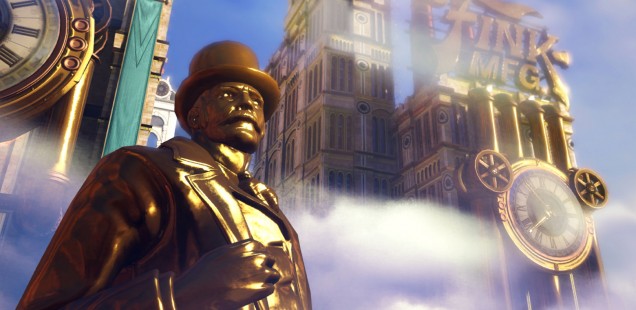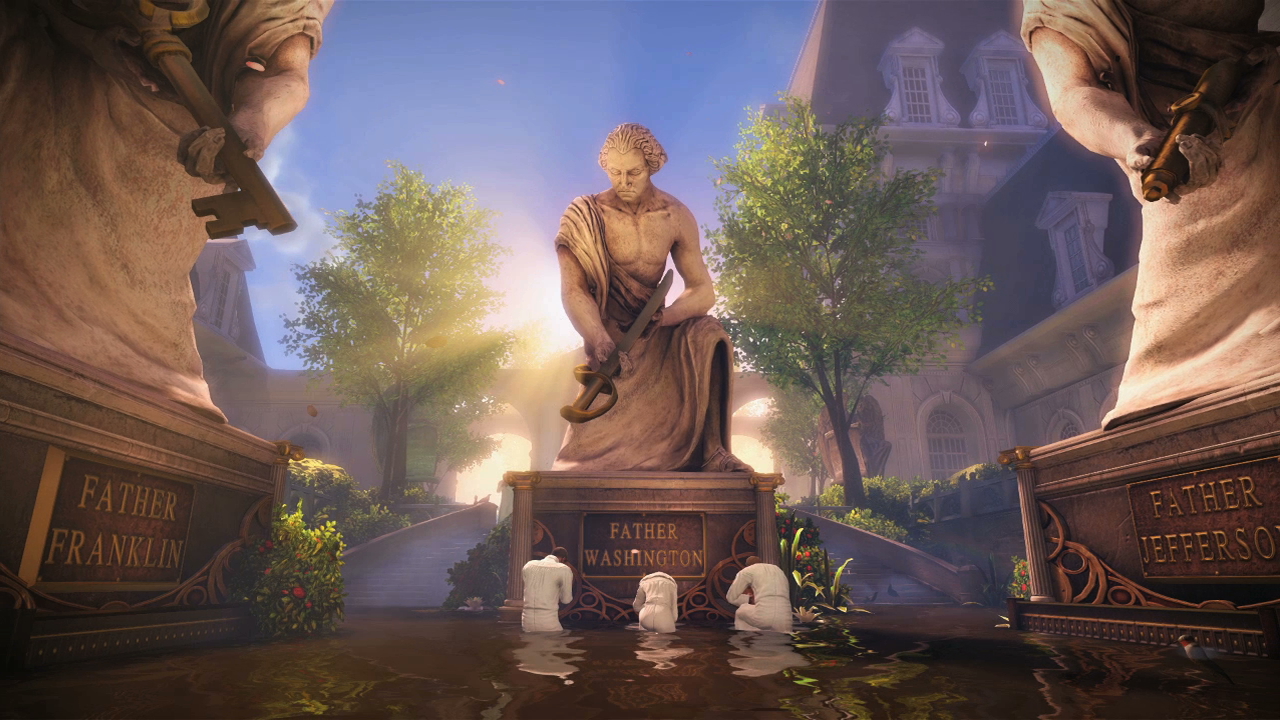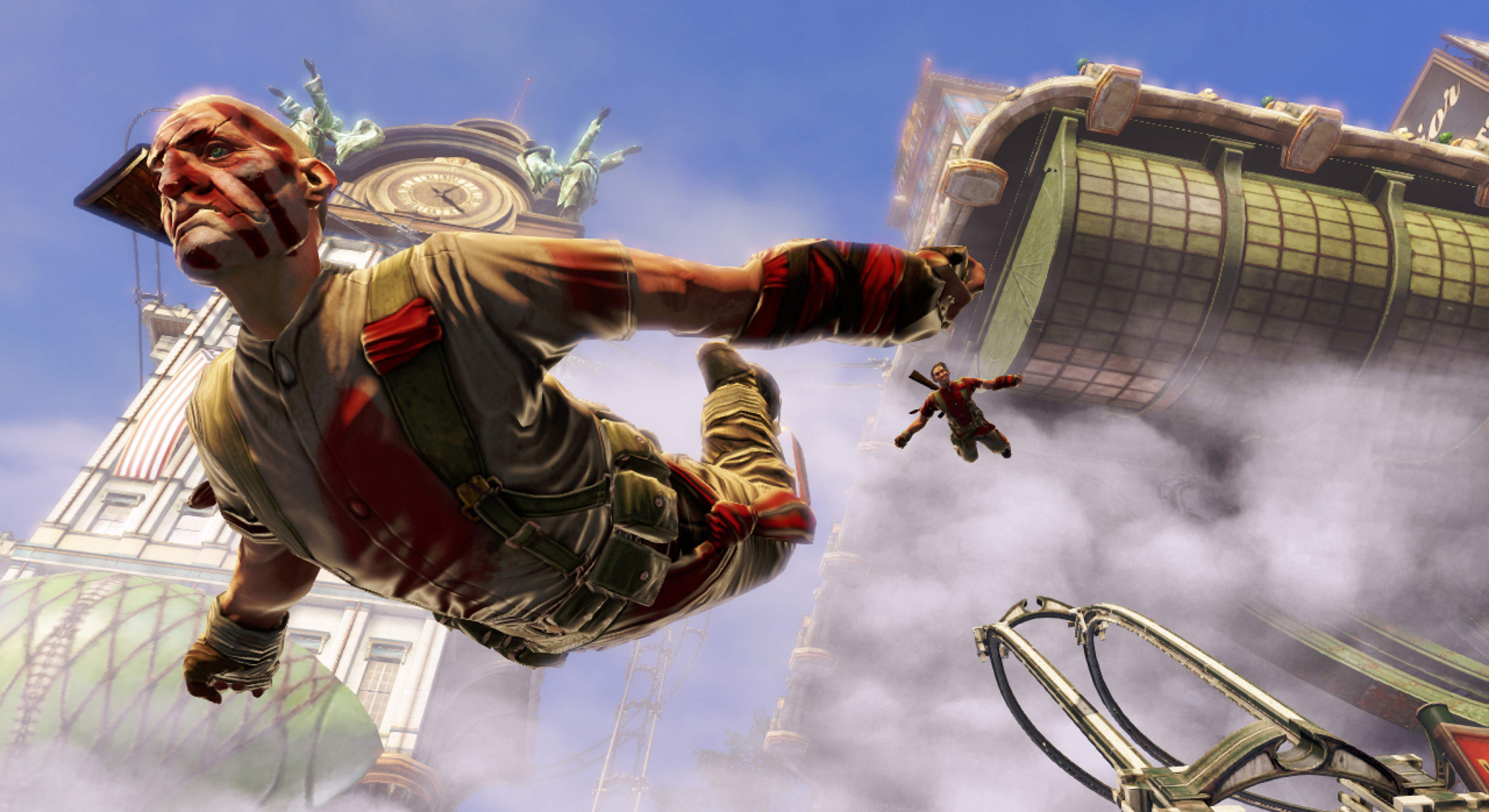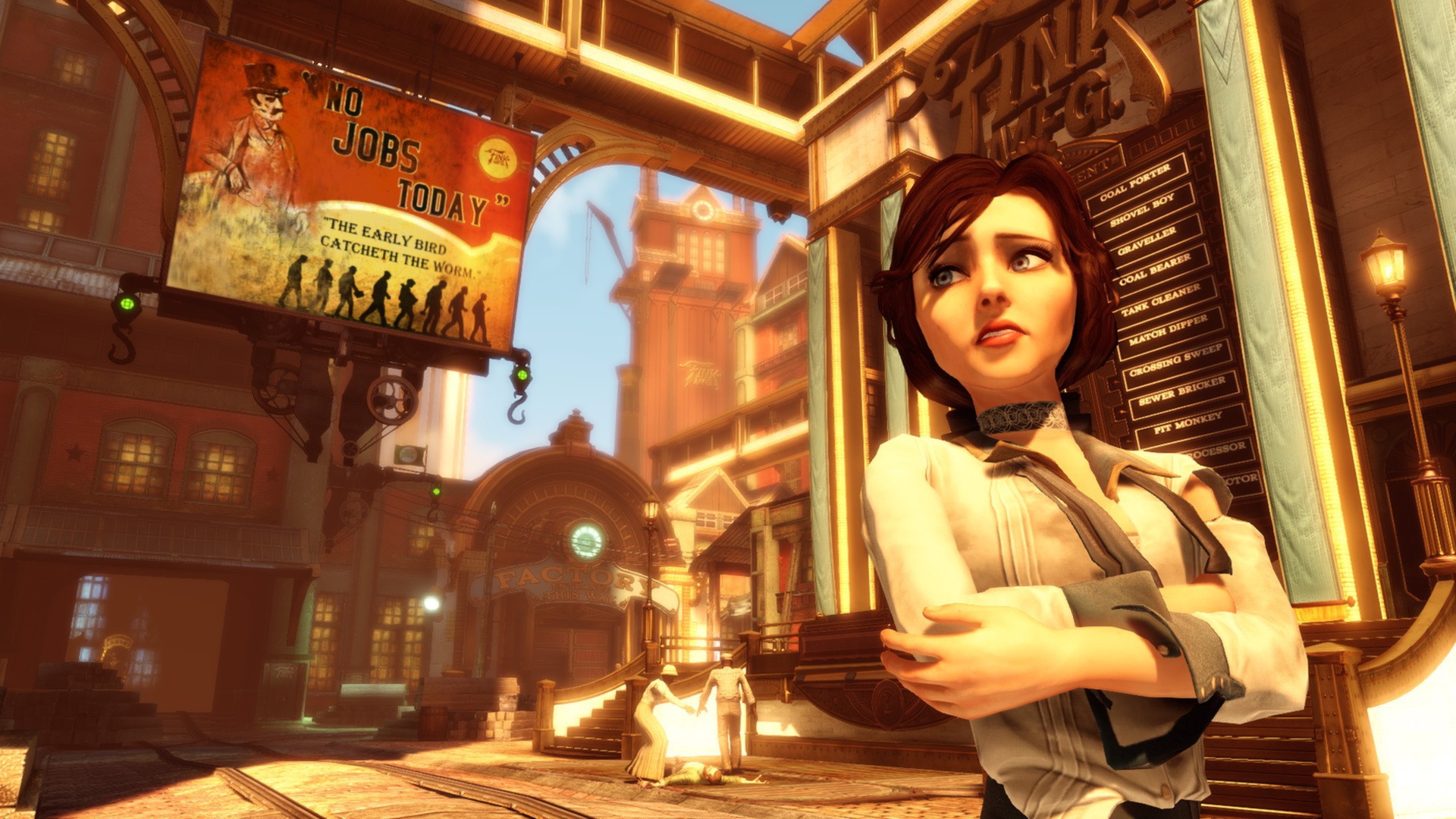
Righteous Fury
Andrew Huntly tackles Bioshock Infinite’s real American influences.
BioShock Infinite is a game about legacy. Not only in theme and narrative, but in its very essence. The original BioShock is one of the most acclaimed games of all time, and possibly the most acclaimed game of its generation. A story of human greed and malice told through the lens of objectivism, it presented a world where ideals are always subject to who we are as people. Utter freedom is a neat idea, but utter freedom also allows for freedom of abuse. BioShock was a game about the dystopia built from the warped idea of a utopia, and how it all fell apart thanks to human nature.
Infinite picks up the same idea. Its central city is Columbia, a land founded on controlling religion and an obsession with American ideals. What tears Columbia apart is not the clashing philosophies of objectivism and libertarianism, but instead the idea of legacy. Columbia burns in flames as its key players all wish to construct their own history.
The most monstrous of these is Comstock, a fanatical religious leader who insists he be deemed as Father Comstock. He is the first thing the game’s anti-hero, Booker DeWitt, sees as he floats down into the city. His face is spread out across a large poster, adorning a tall structure within the city. As Booker floats down further into a church, which doubles as a greeting station, there’s another large image of Comstock, this time a stained glass window showing him leading people to his ‘New Eden.’ Another step into the city, and Booker is confronted with a towering statue of the man brandishing a sword.
You quickly come to realize that Comstock is everywhere.
Comstock is not only a man who wishes to imprint his image upon the people of Columbia, but to warp the idea of American ideals to further himself. His end goal is to rain literal fire upon the people of America below, but not before he constructs his own fantasy up above. Much like the White City of Chicago, Comstock constructs a cardboard land, one where the statues of founding fathers brandishing keys are worshipped outside of a church. Power and control are always present in Comstock’s land.
 He even turns his own squalid, violent history into a place of false heroism and disturbing mockery of his enemies. Columbia is home to the Hall of Heroes, which retells the true, fake version of the Wounded Knee Massacre. In real life, 300 Lakota were slaughtered by U.S troops. It’s an event remembered with sadness as a lingering moment of cruelty in America’s history. For Comstock, it’s a pop-up book of his victories over barbarians who threatened to destroy the purity of America. Same with his retelling of the Boxer Rebellion, which turns a complex issue into a story of yellow skinned evils righteously struck down by Columbia.
He even turns his own squalid, violent history into a place of false heroism and disturbing mockery of his enemies. Columbia is home to the Hall of Heroes, which retells the true, fake version of the Wounded Knee Massacre. In real life, 300 Lakota were slaughtered by U.S troops. It’s an event remembered with sadness as a lingering moment of cruelty in America’s history. For Comstock, it’s a pop-up book of his victories over barbarians who threatened to destroy the purity of America. Same with his retelling of the Boxer Rebellion, which turns a complex issue into a story of yellow skinned evils righteously struck down by Columbia.
Comstock’s strong belief in baptism is a link to the Third Great Awakening, a belief that the second coming of Jesus Christ would occur once society was ready. “Ready” in this case meant purely Christian, and modelled on Christian ethics. The emphasis on behavioural modification to achieve this goal ties into later events of Infinite, when Comstock uses mental torture to break his daughter Elizabeth to get her to carry out his heinous tasks.
In many ways, Comstock’s Columbia is a dark reflection of America’s history as skewed by extreme pride and nationalism. It’s a place built on unwavering devotion to the founding fathers, where America’s foes are seen as subhuman, where a patriarch can lord over his sheep and turn the darker skinned or wrongly baptized into exploited, abused labor.
Much of Comstock’s Columbia may sound exaggerated. It isn’t. Between 1900 and 1920, it was common for immigrants to be greeted in America with signs telling them ‘No Irish Allowed’ or ‘The Chinese Must Go’. During World War I, Carl C. Brigham tested American military recruits according to the terrible pseudo-science of the time. He discovered: “The intellectual superiority of our Nordic group over the Alpine, Mediterranean, and negro groups has been demonstrated.” Looking at BioShock Infinite as a hyperbolic exaggeration is faulty – it simply distills that attitude and those ideas.
This is especially true in the oft criticized revolution that takes place within the game, seen as problematic for portraying Columbia’s minorities as barbarians who deserve to be kept at bay, and comparing their violent resistance to Comstock’s system of racist ultranationalism. When I read the game, I see not an examination of how the oppressed are as monstrous as their oppressors, but how the ignorance and hatred of turn of the century America used economics to disempower those it deemed unworthy. And then, the disenfranchisement became so extreme that the only logical conclusion was bloody war.
 Comstock and Fitzroy are comparable, though only in how they define their differing brands of extremist ideology. Fitzroy only represents the mistreated people of America in the way Comstock represents white, privileged America – that is, the extremism and the barbarism. But one wouldn’t say that Comstock defines all American white people, and so Fitzroy does not define all disenfranchised people.
Comstock and Fitzroy are comparable, though only in how they define their differing brands of extremist ideology. Fitzroy only represents the mistreated people of America in the way Comstock represents white, privileged America – that is, the extremism and the barbarism. But one wouldn’t say that Comstock defines all American white people, and so Fitzroy does not define all disenfranchised people.
As with the first BioShock, Infinite is a game about extremism more so than any particular ideology. Libertarianism is an accepted and relatively popular sociological idea in modern society, but Andrew Ryan’s extremist brand lead only to ruin and downfall. The same can be said of Comstock – patriotism in American society is common, but Comstock took it to such hateful extremes that he created the fiery cleansing of Fitzroy and the Vox Populi.
Racism is but a starting point for atrocity. Like all discrimination, it is one of the greatest evils for the further evil it allows to happen. In the case of America in the early 1900s, the beginnings of resistance to centuries of abuse had only really secured a slightly less atrocious deal, life in workhouses. These were basically prisons of labor, where workers were paid astonishingly low wages for 18 hours of work, if not more, in a day. And where else could they go? While Lincoln had unshackled slavery’s chain, a thick, disgusting streak of hatred still lay nestled in American society.
With it came those hoping to profiteer. They built the workhouses and told those cast out from decent work that this would be their safe harbor. The wages were appalling, the conditions worse and workers died more frequently than not. In BioShock Infinite, this is represented by Jeremiah Fink, an industrialist who preaches long hours, hard work and broken bones as something of a cure to the broken minorities he keeps in his workhouses and slums. He and Comstock exploit these people, demanding their servitude and soul for the good grace of keeping lesser people within Columbia. This systematic abuse naturally leads to resistance.
At the turn of the century, violence from lower classes and anarchist movements was prevalent across Europe and America. The President of France was assassinated in 1894, and in the following decade Empress Elizabeth of Austria-Hungary was stabbed to death and both U.S President William McKinley and Prime Minister of Spain Antonio Cánovas were shot by anarchists. In America, financial institutions suffered anti-capitalist attacks. A bombing in L.A in 1910 killed 23 people, a detonated carriage in Wall Street in 1920 killed 38 and wounded over 140. Relations between the extremist underprivileged and the bourgeois around the time were violent, bitter and angry.
 BioShock Infinite takes this to its apex in a full blown revolution. The Vox Populi, consisting of the disenfranchised and the exploited, the blacks, whites, Jewish, Catholic and anyone Comstock has deemed more creature than person, rise up and begin to tear Columbia apart. Led by Daisy Fitzroy, a woman who once idolized Comstock’s wife but vowed revenge after being accused of her murder, they slaughter Columbia’s high officials and set the torch to its walls.
BioShock Infinite takes this to its apex in a full blown revolution. The Vox Populi, consisting of the disenfranchised and the exploited, the blacks, whites, Jewish, Catholic and anyone Comstock has deemed more creature than person, rise up and begin to tear Columbia apart. Led by Daisy Fitzroy, a woman who once idolized Comstock’s wife but vowed revenge after being accused of her murder, they slaughter Columbia’s high officials and set the torch to its walls.
Daisy Fitzroy, however, is burdened with her own desires for legacy. At one point she orders Booker’s death for he “only complicates the narrative.” Revolutionaries can start an uprising for something good, but might find themselves too concerned with image. The key figure of the Russian Revolution is currently embalmed and on display in Moscow. Che Guevara’s face has become more iconic than anything he fought for. The imagery of a revolution is as powerful as any of its weapons.
Fitzroy becomes obsessed with a crusade rather than an end goal. Of a series of events and an idea, rather than any actual liberation. None of this is the game telling us Fitzroy’s ideas are cruel, or even unwise, but it’s simply about how she becomes enamored with presentation. Much like Comstock has positioned himself as the ideal figurehead for his own ideology, so has Fitzroy. It’s not about ideas – it’s about people who manipulate those ideas for themselves, a theme carried from the first BioShock.
“History is always written by the victor” is how the saying goes, and BioShock Infinite is aware of their lies. To refer back to that empty, cold White City of Chicago, on the surface it’s a gorgeous place of life and pride. Beneath, it’s violent, angry and even insecure, needing to justify its existence. Columbia is much like the gargantuan angel statue that resides at its core – a reference to the earthbound Statue of of the Republic that hides an abused, neglected young girl. Systematic abuse will breed a dissent that turns violent and nasty. History has shown this, and Infinite uses that history to construct a condensed vision of that nationalistic, violent America. The revolution that overthrows it is simply equally condensed.
BioShock Infinite is not specifically about race, or religion, or labor. It’s a game about America, a country that is darkly defined by all of these things. America has always had trouble with its bloody, messy history, and so Infinite tells a story of people who wish to redefine that bloody, messy history into something puritanical and justified, by turning it into a story of heroes and villains, when nothing is ever that simple. Neither Comstock nor Fitzroy will have much of a legacy in the end. Their dreams of greater acknowledgement, of turning history into their own story, is their individual downfall. At the end of the game, it is Booker’s choice to die before he creates any legacy, for his legacy is one only of monstrosity. And for that, he’s rewarded with what he always wanted: a life of normality with his child. Not to be history and not to define history, but simply to live.
Andrew Huntly’s cinematic rants have been complimented on British radio shows and their associated podcasts.